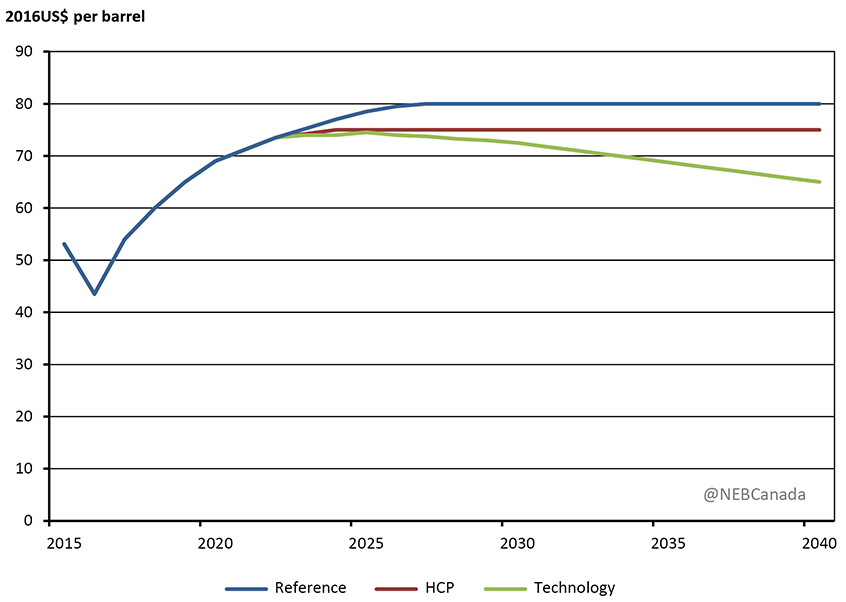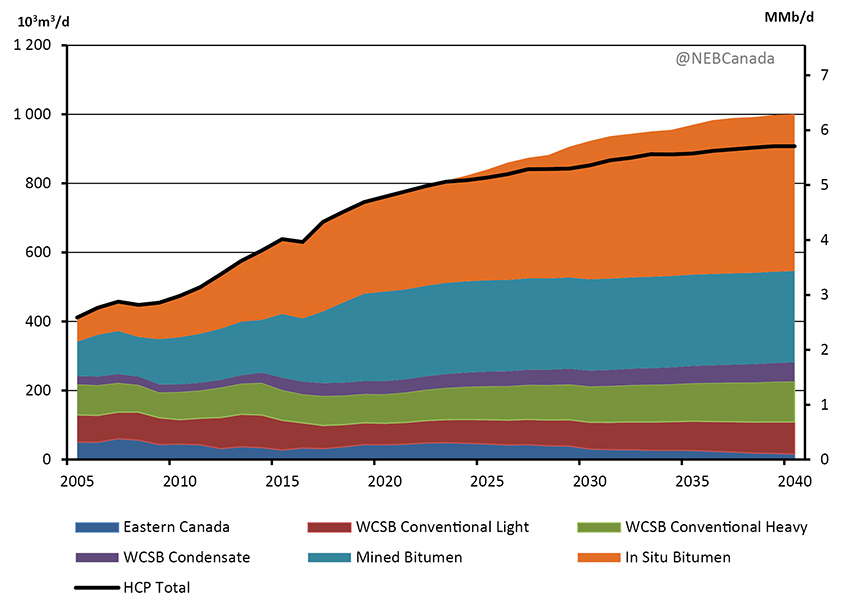ARCHIVED – Fact Sheet - Canada’s Energy Future 2017: Energy Supply and Demand Projections to 2040 - Crude Oil Production
This page has been archived on the Web
Information identified as archived is provided for reference, research or recordkeeping purposes. It is not subject to the Government of Canada Web Standards and has not been altered or updated since it was archived. Please contact us to request a format other than those available.
Crude Oil Prices
- The Reference Case Brent crude oil price assumption, in constant 2016 dollar terms, reaches US$80/bbl by 2027, and stays at that level through the remainder of the projection period.
- The Brent crude oil price is lower in the Higher Carbon Price (HCP) and Technology cases. In both cases, the Brent crude oil price follows the trajectory of the Reference Case until 2022. Thereafter, the prices diverge, with prices in the HCP Case reaching US$75/bbl in constant 2016 dollar terms. The Technology Case assumes that the Brent price begins to slowly decline, reaching US$65/bbl in 2040, US$15/bbl lower than in the Reference Case.
- The HCP Case assumes greater global climate action relative to the Reference Case. This implies lower demand for GHG emission-intensive goods, including refined petroleum products such as gasoline and diesel, and crude oil. Similarly, in the Technology Case, greater global adoption of technologies like electric vehicles implies lower demand for crude oil compared to the Reference Case. The difference between the cases in EF2017 is not an assessment of the impact of greater climate action on crude oil prices but is an assumption with which to build broad and plausible scenarios.
Brent Crude Oil Price, All Cases

Crude Oil Production
- By 2040 Canadian crude oil production in the Reference Case is 1 000 thousand cubic metres per day (103m3/d) or 6.3 million barrels per day (MMb/d). This is 59% higher than 2016 levels of 631 103m3/d (4.0 MMb/d). Total oil production in the HCP Case reaches 908 103m3/d (5.7 MMb/d) by 2040, 9% lower than in the Reference Case.
- Oil sands production in 2016 was 405 103m3/d (2.5 MMb/d). At nearly two-thirds of total Canadian oil production in 2016, oil sands make up most of the production growth over the projection period. Oil sands production in the Reference Case increases by 77% from 2016 to 2040, reaching 718 103m3/d (4.5 MMb/d).
Total Canadian Crude Oil and Equivalent Production, Reference and HCP Cases

- After mining projects currently under construction are completed and their production is brought up to capacity, no additional mining capacity is added over the projection period. In both cases, crude oil prices do not reach high enough levels to encourage new investment. After 2024, mined bitumen production in the Reference and HCP cases stay constant at 265 103m3/d (1.7 MMb/d).
- In the Reference Case, in situ bitumen production more than doubles from 2016 to 2040, reaching 453 103m3/d (2.9 MMb/d) in 2040, up from 222 103m3/d (1.4 MMb/d) in 2016. The crude oil price assumptions in the Reference Case encourage sufficient investment to grow production, particularly by experienced producers with high quality deposits.
- In the HCP Case, in situ production continues to grow but more slowly than in the Reference Case. This is driven by: 1) the assumption of lower global crude oil prices in the HCP Case, 2) higher carbon prices than in the Reference Case.
- Together, higher carbon costs and lower crude oil prices in the HCP Case cause in situ production to grow slower, reaching 402 103m3/d (2.5 MMb/d) in 2040, or 11% lower than in the Reference Case. Some more costly and emission-intensive projects that are included in the Reference Case are excluded from the HCP Case.
- In the Technology Case, oil sands producers increasingly use steam-solvent technologies for in situ oil sands projects. This reduces the per barrel costs for new projects and expansions of existing projects. Lower supply costs are partially offset by the lower price assumptions in the Technology Case and production reaches 416 103m3/d (2.6 MMb/d) by 2040, 3% higher than in the HCP Case.
- Date modified:
